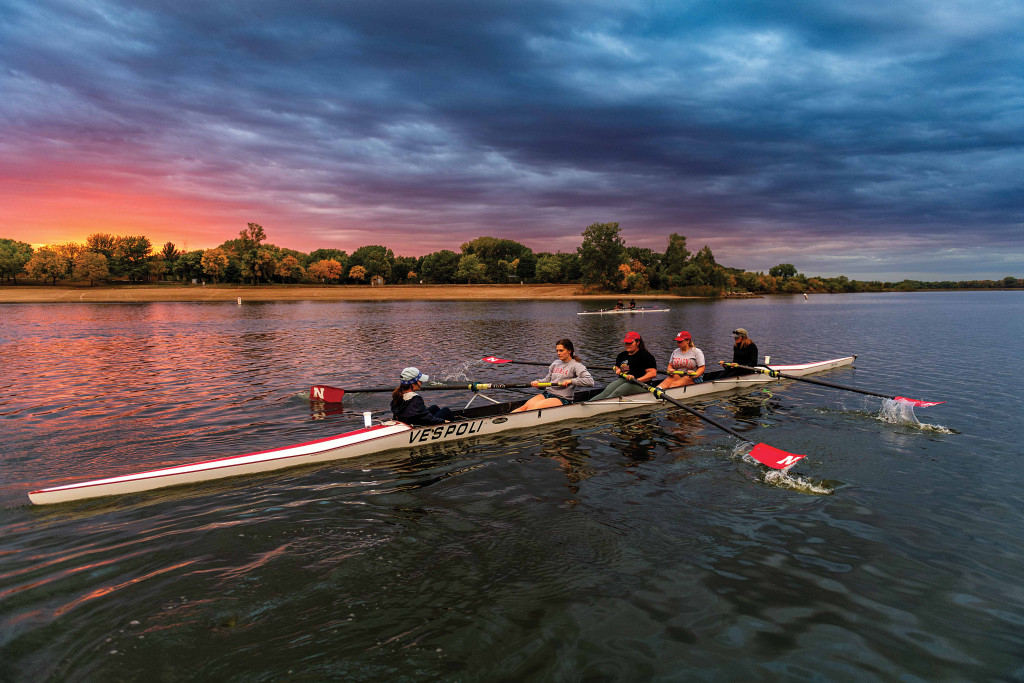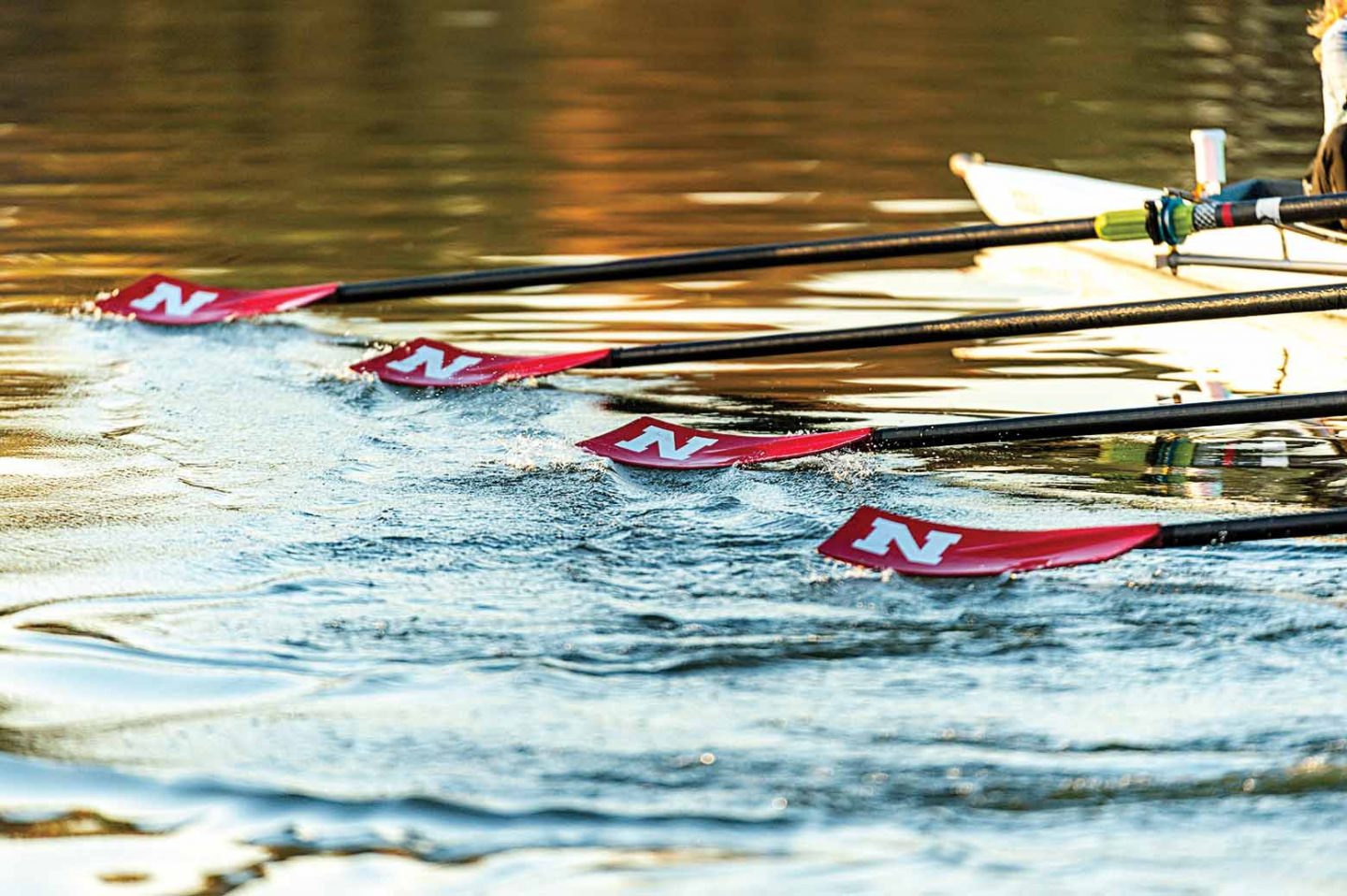
By Eric Fowler
When Kevin Fierro came to the University of Nebraska – Lincoln in the fall of 2020, he knew little about rowing, much less that the school had a club crew team.
“I’d only seen those types of boats maybe twice in my life on TV,” said Fierro, a graduate of Grand Island High School, who like many Americans, only see the sport every four years when the Olympics roll around.
This fall, Fierro will start his third year on the club team, which spends evenings rowing on Pawnee State Recreation Area from ice-out in March through early November, traveling to regattas around the Midwest in the spring and fall, and countless hours on rowing machines in the club’s boat house on campus and competing in inland races during winter. These are not, after all, your typical rowboats.
He is one of many who have hit the water to Row Big Red.
Let’s Row
In 1970, when Allen Maybee of Scottsbluff first started recruiting members for UNL’s rowing team, he didn’t even have an oar, much less a boat. He promised the prospects he would by the time the ice went off the lakes the following spring. He sent letters to 54 rowing organizations asking if they had equipment to spare and spent the winter driving around the eastern U.S., picking up gear that was donated or offered for sale. Then, in the spring of 1971, 40 crewmen who had never rowed a shell put on an exhibition at Capital Beach in Lincoln. A women’s team was formed in 1973.
For the first 50 years, the team practiced at Branched Oak State Recreation Area. Equipment was stored in Mead and transported to the lake each practice until Maybee appropriated an unused maintenance building on campus for its boat house and, somehow, managed to not get evicted when officials found out. They continue to use that building today.

Nebraska’s team was competitive, at one point rolling off six straight Big Eight championships in the 1970s. They regularly competed in the Head of the Charles, one of the world’s largest and most prestigious regattas, in the Boston area. There, they competed against the likes of Harvard and Yale, who held the first intercollegiate competition of any kind when their crew teams faced off in 1852.
A few team members kept rowing beyond college, competing on a national and international scale. Lisa Rohde, a farm girl from Hubbard, won a silver medal in rowing in the 1984 Olympics. George Pagano and Caitlin Miller rowed across the Atlantic Ocean in 2015.
Still Rowing
In 2021, the club moved its practices to Pawnee State Recreation Area, where, in partnership with the Nebraska Game and Parks Commission, they leased half of the renovated marina building, where they trained on rowing machines and stored equipment. Outside, there is a boat pen where the vessels are stored and new docks.
Membership in the club last school year was about 20 students, well below what was in decades past, but double what it was the year before. Eric Jensen, who in 2021 became the club’s first paid coach in years thanks to an active alumni group, Friends of Nebraska Rowing, hopes to return to that level in both membership and competitiveness. Jensen, who got into rowing after college and coached a few college teams before moving to Nebraska, hopes to boost their numbers to between 40 and 70 in the near future.

A majority of the current members are former high school athletes looking for a competitive outlet in college. Of the 16 that rowed competitively last year, just three had some experience in the sport. Katie Orr was one, having rowed in high school in Rochester, Minnesota. She didn’t know Nebraska had a crew team when she came to Lincoln but was happy it did when she found she was “just missing something.”
“There’s just no other sport like it,” Orr said. “Every time you push that oar in the water, there’s some kind of sound you’re looking for.”
The sport is a full-body workout, said Jensen, using nearly every muscle from the legs to the fingers. The 2,000-meter sprint races are compared to running 2 miles or playing back-to-back basketball games. The longer, 5,000-meter head races include sprints at the beginning and end. Blisters come quick in the early practices, eventually turning to callouses.

Then there is the off-season, when they train all winter long on rowing machines. “It’s boring as heck,” Jensen said. “Too bad it’s the longest season.”
But it’s also the time to work on the physical and technical parts of the sport. The stroke rate of each person on the boat has to be perfectly timed to perform well. If not, you might not even stay upright, as Fierro knows all too well. The first time he rowed, he capsized in his first strokes on a double. “Instead of puffing air, you’re sucking on water,” he said.
Assistant coach Libby Bicak learned to appreciate the mental aspect of the sport while rowing in college and still does on the Omaha Rowing Club. “For an hour and a half, you can’t think about anything else that’s going on,” she said.
“When you push the dock away, you push the world away with it,” Jensen added.
Rowing for Nebraska
The biggest challenge for the University of Nebraska crew team is the weather. Each school in the region has its own battles on that front. Here, they deal with rain, snow and, of course, wind. “We row in everything, just not the hard water,” Fierro said.
The new facilities at Pawnee will help. The dock in the marina is protected from the wind and waves, making it easy to get sculls on and off the water. As long as there aren’t whitecaps on the lake, they can typically find smooth water on one tree-lined shore or the other. If they can’t get on the water, they continue their indoor training.
Last spring, for the first time in several years, Nebraska sent a team to the ACRA National Championship Regatta in Tennessee. Orr was part of that coxed four team that finished 18th out of 27 teams. Her college career now over, Orr, like past club members, will look for the opportunity to row wherever life takes her next.

Fierro isn’t sure yet after being plagued by injuries that date to high school, but also include pulling the lats muscles in his back. How do you do that? “Pull to hard,” Fierro said, with a mix of pride and shame.
“Kevin broke a handle off an oar one time,” Orr said with a laugh, offering further explanation on her teammate.
Wherever they go, they will remember their time rowing for Nebraska Crew. They will remember the good and bad weather. And the sunsets that come earlier every fall practice, which by season’s end finish up in the dark, in landlocked Nebraska.
Rowing 101
Competitive rowing utilizes one-, two-, four- and eight-person shells measuring between 27 and 58 feet in length and as narrow as 10 inches wide. Typically made of carbon fiber today, compared to wood in the past, shells weigh from 23 to 230 pounds. New boats range in price from $15,000 to more than $60,000.
In sweep rowing, each person has a single oar. Eight-person sweep boats always include a coxswain who coaches the rowers on the water and steers the boat via its rudder. Two- and four-person sweep boats may or may not include a coxswain.
In sculling, rowers hold an oar in each hand. These boats come in one-, two- and four-person versions.
The eight is the fastest, with top teams reaching nearly 14 mph, and enough power to pull a water skier.
Oars are attached to the boat via riggers. A rower’s feet are stationary, locked into a stretcher with special shoes. Rowers sit on a seat that slides back and forth with each stroke.
The UNL Crew team competes in the American Collegiate Rowing Association. The fall season includes time-trials held on rivers. While typically
5 km long, the distance can be shorter depending on the river. In the spring, the races are 2 km sprints held on lakes, with several boats going head-to-head from a dead start to the finish line. The latter is the format used in the Olympics.
Every school in the Big Ten Conference has a rowing team. At some schools, women’s rowing is a NCAA varsity sport. Creighton University has a women’s rowing team.
